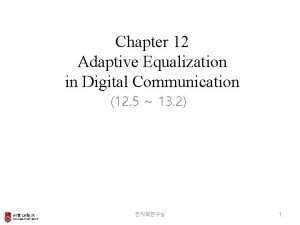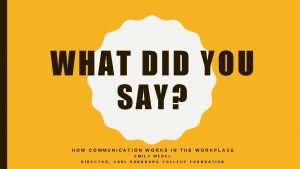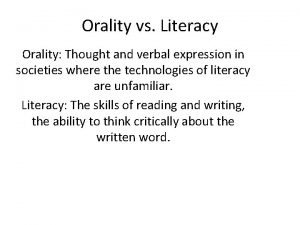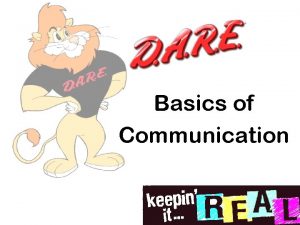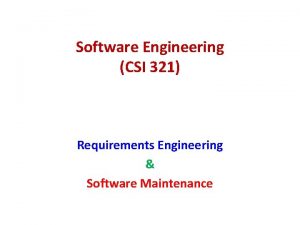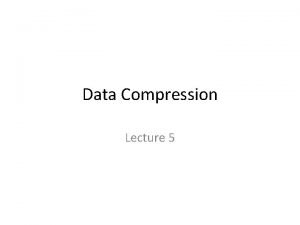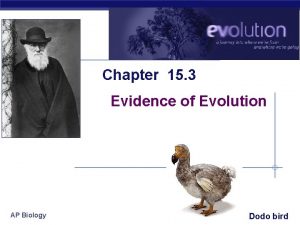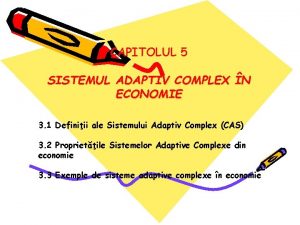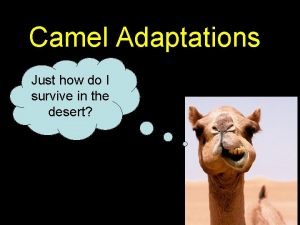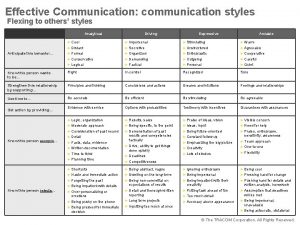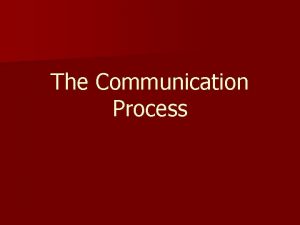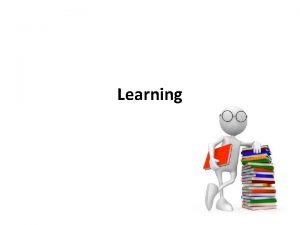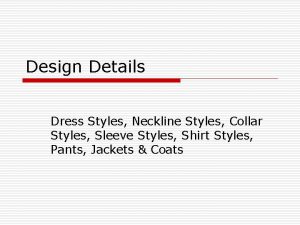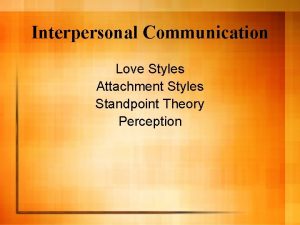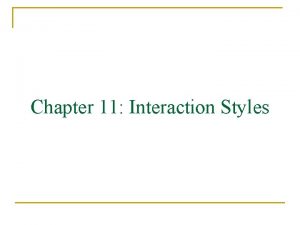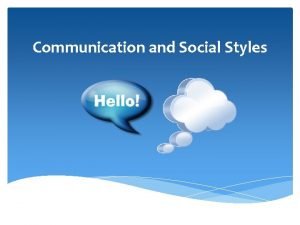Chapter 4 Communication Styles A Key to Adaptive









































- Slides: 41

Chapter 4 Communication Styles: A Key to Adaptive Selling Today, 12 th Edition (pages 70 -91) Allen Wysocki wysocki@ufl. edu Food and Resource Economics Lectures© may not be used without permission

Chapter Objectives (Chapter 4) After this unit, you should be able to: 1. Discuss how communication style influences the relationship in selling. 2. Identify two major dimensions of the communication-style model. 3. Explain the four communication styles in the communication-style model. 4. Learn how to identify your preferred communication style and that of your customer. 5. Learn to achieve sales versatility. Chapter 4: Communication Styles 2

Communication Process Selling Process = Communication Sending a message Encoding Process Decoding Chapter 4: Communication Styles 3

Shared Field of Experience 1. Easy Communication 2. Some Communication 3. Difficult Communication Field of Experience Chapter 4: Communication Styles 4

Communication Style Communication style: the patterns of behavior that others observe. o These patterns help us to form impressions about others since we do not know others’ inner-most thoughts and feelings 1 Chapter 4: Communication Styles 5

Communication Style Principles 1. Individual differences exist and are important 2. A communication style is a way of thinking and behaving 3. Individual styles tend to be stable . 4. There is a finite number of styles 5. To create the most productive relationships, get in sync with the communication style of the people you work with Chapter 4: Communication Styles 6

Communication Style Equivalents Analytical Reflective (Manning/Reece) Driver Directive (Manning/Reece) Conserving-Holding (Stuart Atkins) Controlling-Taking (Stuart Atkins) Directive (People Smarts) Thinker (People Smarts) Cautiousness (Personal Profile System) Dominance (Personal Profile System) Conscientious (Di. SC Behavioral Style) Dominance (Di. SC Behavioral Style) Amiable Expressive Supportive (Manning/Reece) Emotive (Manning/Reece) Supportive-Giving (Stuart Atkins) Adaptive-Dealing (Stuart Atkins) Relater (People Smarts) Socializer (People Smarts) Steadiness (Personal Profile System) Influencing (Personal Profile System) Supportive (Di. SC Behavioral Style) Influencing (Di. SC Behavioral Style) Source: Figure 4. 8, p. 82 Chapter 4: Communication Styles 7

Communication Styles Style refers to how a person communicates their Message. Style may change depending upon the message Two criteria are used to identify an individual’s communication style: 1. Responsiveness. 2. Assertiveness. Chapter 4: Communication Styles 8

Major Parts of Communication There are three major parts in human face to face communication which are: o Body language, voice tonality, and words. 55%. of impact is determined by body language--postures, gestures, and eye contact 38% . by the tone of voice 7%. by the content or the words used in the communication process Chapter 4: Communication Styles 9

Calculate Your Social Style Chapter 4: Communication Styles 10

D Low Task-Directed C B A 1 Analytical Driver 2 Ask. Directed Tell. Directed 3 Amiable High Expressive Used with permission of Wilson Learning Corporation © 4 Low High People-Directed Chapter 4: Communication Styles 11

Assertiveness & Responsiveness Assertiveness is an indicator of pace o The way in which a person is perceived as attempting to influence thoughts and actions of others Low A = Easy-going pace, Ask-Directed High A = Fast pace, Tell-Directed . . Responsiveness is an indicator of priorities o The way in which a person is perceived as expressing feelings when relating to others o Low R = Goal oriented or Task-Directed. o High R = People-Directed. Chapter 4: Communication Styles 12

Assertiveness: The way in which a person is perceived as attempting to influence thoughts and actions of others ASK Directe d Indirect Used with permission of Wilson Learning Corporation © TELL Directe d Approach Direct Conditional Statements Declarative More Questions Fewer Pace Faster Few Interruptions Many Leans Back Body Position Leans Forward Deliberate Quieter Volume Less Direct Eye Contact Takes Time Decisions Louder More Direct Responds Quickly Chapter 4: Communication Styles 13

Responsiveness: The way in which a person is perceived as expressing feelings when with permission of Wilson Learning Corporation © relating to others Used TASK Focus Directed Gesture Facts first, relationship second Fewer, close to the body Tone Consistent, even Feelings Share few Facial Expression Fewer Decision-Making Objective, relies on logic Relationship first, facts second Focus Move away from body Tone Varied Feelings Share many Facial Expression More Subjective, relies on Gesture PEOPLE Directed Decision-Making Chapter 4: Communication Styles 14

R E S P O N S i V E S S Four Social Styles Analytical n n n Detail oriented Deliberate Well organized Respect Driver n n n Amiable n n n Decisive Forceful Results oriented Control Expressive Warm Supportive Attentive n n n Approval Fast-paced Outgoing Enthusiastic Recognition ASSERTIVENESS Used with permission of Wilson Learning Corporation © Chapter 4: Communication Styles 15

Task-Directed C D Low 1 Analytical Driving Analytical 2 Amiable Analytical B Analytical Driver A Driving Driver Expressive Analytical Amiable Driver Expressive Driver Ask. Directed Tell. Directed 3 Analytical Amiable Driving Amiable High 4 Amiable Analytical Expressive Driving Expressive Amiable Expressive Low Expressive High People-Directed Chapter 4: Communication Styles 16

The Answer: Versatility The ability to adapt one’s own behaviors to meet the concerns and expectations of others in order to create productive relationships Chapter 4: Communication Styles 17

IDENTIFY Style - Guidelines § Observe one dimension at a time § Assertiveness o Pace, Voice, Body Language § Responsiveness o Voice, Body Language, Focus § Observe behavior—don’t guess § Balance your observations—verbal and § nonverbal Keep it simple—don’t overcomplicate Used with permission of Wilson Learning Corporation © Chapter 4: Communication Styles 18

IDENTIFY Style at a Distance With email o Notice priorities: relationship or task first o Use of language: declarative, conditional o Use of emoticons or unique formatting On the phone o Tone and pace of voice o Use of language: declarative, conditional First meeting o Ask questions of other people Used with permission of Wilson Learning Corporation © Chapter 4: Communication Styles 19

REFLECT on Style Preferences and Expectations Used with permission of Wilson Learning Corporation © Analyticals want … Drivers want … § A more formal and structured approach § A businesslike attitude with a focus on effective problem solving § Efficient use of time § Evidence of results § Strong product knowledge § Documentation and facts § Clear benefits § Support for their ideas § Options and choices § Power § Enough time to think things through § Evidence of how results were achieved § Clear, logical processes § Support for their thinking and principles § Data that aids decision making § Respect Amiables want … Expressives want … § An open and honest approach § Time to develop the relationship with coworkers § Support for feelings § Assurances § Others’ involvement in the decision-making process § Clarity of impact on others § To know why it’s right § Approval § More flexible use of time § Discussions that keep moving and stay focused § Others to get to know them as people § Personal recognition for their ideas and actions § Strong product knowledge § Not too much detail § Testimonials as evidence of success Chapter 4: Communication Styles § Recognition 20

MODIFY Tactics § Pace The speed of your speech and physical movements § Voice The use of emphasis, tone, and volume § Body Language The use of gestures, facial expression, and interpersonal distance § Focus/Content The discussion topics and priorities Used with permission of Wilson Learning Corporation © Chapter 4: Communication Styles 21

MODIFY Assertiveness ASK MORE TELL MORE Ask more questions Decrease pace Decrease volume Be more indirect Make more statements Increase pace Increase volume Be more direct Used with permission of Wilson Learning Corporation © Chapter 4: Communication Styles 22

MODIFY Responsiveness MORE TASK Get to task quickly Limit expression of feelings Gesture less Share fewer feelings MORE PEOPLE Focus more on relationship Increase expression of feelings Gesture more Share more feelings Used with permission of Wilson Learning Corporation © Chapter 4: Communication Styles 23

Presenting to Analyticals a. Opening o Of fair Importance o State. purpose early o Develop a professional relationship b. Presentation o Provide considerable Detail o Reduce emotion o Be Systematic or linear . . Chapter 4: Communication Styles 24

Presenting to Analyticals… c. Handling Objections o Provide detailed analysis o Use research findings d. Closing o Summarize +’s and o Demonstrate Bottom -’s. line e. Follow-Up o Continually supply relevant information and research Chapter 4: Communication Styles 25

Selling to Analyticals Example Video Chapter 4: Communication Styles 26

Presenting to Drivers a. Opening o Be Confident o Brief and to the firm handshake, strong grip. Point b. Presentation o Confident and to the point o Communicate benefits to their goals o Quick demonstration Chapter 4: Communication Styles 27

Presenting to Drivers… c. Handling Objections o Always verify agreement on objections o Negotiate directly, don’t Avoid. d. Closing Bottom line o Demonstrate o Straight forward, emphasize their goals e. Follow-Up o Ask how product is doing, offer assistance Chapter 4: Communication Styles 28

Selling to Drivers Example Video Example Chapter 4: Communication Styles 29

Presenting to Amiables a. Opening o Very o Build a important Personal relationship b. Presentation o Involve the prospect as much as possible o High interaction and relaxed environment Chapter 4: Communication Styles 30

Presenting to Amiables… c. Handling Objections o Rely on personal assurances such as testimonials & your word o Build trust, not conflict d. Closing o Don’t be Pushy. o Stay friendly and reassuring e. Follow-Up o Very important, amiables buy the Person. Chapter 4: Communication Styles 31

Selling to Amiables Example Video Example Chapter 4: Communication Styles 32

Presenting to Expressives a. Opening o o o Have a positive attitude Let them Talk about themselves Maintain a high energy level Ask a lot of questions about them Compliment their abilities and achievements b. Presentation o Make it Snappy, Liven o Maintain a quick pace it up Chapter 4: Communication Styles 33

Presenting to Expressives… c. Handling Objections o Be Confident and candid d. Closing o Should be lively o Address prospect’s Goals . e. Follow-Up o Very important, maintain enthusiastic and friendly relationship Chapter 4: Communication Styles 34

Selling to Expressives Example Video Example Chapter 4: Communication Styles 35

MODIFY at a Distance Voice Mail o Analyticals: be logical, clear, more formal o Expressives: state who and why at the start, indicate feelings, and provide a high level of detail o Amiables: start with a greeting, explain the “why”, be informal o Drivers: get immediately to the point, be concise, emphasize actions to be taken Used with permission of Wilson Learning Corporation © Chapter 4: Communication Styles 36

Styles in Conflict Autocratic Acquiescing T FI G H FL I G H T Avoiding Attacking Used with permission of Wilson Learning Corporation © Chapter 4: Communication Styles 37

Back-up Behavior—Four Styles FLIGHT Autocratic Avoiding n n Avoids confrontation Draws attention away from an issue Retreats to other distractions Delays decision; controls emotions n n n n Confronts others Focuses on the issue Looks for rationale Becomes demanding Attacking Acquiescing n FIGHT Smooths relationships Yields to others’ viewpoints Wavers on opinion; hesitates Gives in; withdraws support n n Confronts others Verbalizes judgmental feelings Blames others on a personal leve Shows extreme emotion Used with permission of Wilson Learning Corporation © Chapter 4: Communication Styles 38

Z Patterns: When Tension Increases Used with permission of Wilson Learning Corporation © Chapter 4: Communication Styles 39

Which Style is Best? Communication means adapting your style o http: //www. youtube. com/watch? v=kh. MTx 9 e. Wwho&feature=Pl ay. List&p=FD 1 DC 97017 A 024 FC&index=8 o http: //www. youtube. com/watch? v=Squtgpc 2 t 1 Y No style is always preferred You should adopt Pace & Priorities that best facilitates communication Your style should be Consistent with the customer’s style Crossed communication is when there is conflict in assertiveness and/or responsiveness Chapter 4: Communication Styles 40

References 1. Mike Mc. Namee and Christopher Schmitt. “The Chainsaw Al Massacre, ” Business Week, May 28, 2001, p. 48; Dennis K. Berman and Jaonn S. Lublin, “Restructuring, Personality Clashes Led to Lucent Executive’s Exit, Wall Street Journal, May 17, 2001, p. B 1. Chapter 4: Communication Styles 41
 Chapter 15 furniture styles and construction answer key
Chapter 15 furniture styles and construction answer key Adaptive communication environment
Adaptive communication environment Adaptive equalization in digital communication
Adaptive equalization in digital communication Communication styles in the workplace
Communication styles in the workplace Example of formal communicative style
Example of formal communicative style Listening in interpersonal communication
Listening in interpersonal communication Communication styles turtle tiger owl
Communication styles turtle tiger owl Driver communication style
Driver communication style Orality examples
Orality examples Three styles of communication
Three styles of communication Black and white styles in conflict
Black and white styles in conflict Communication styles survey
Communication styles survey Communication styles
Communication styles Communication styles
Communication styles Dare communication styles
Dare communication styles Communication styles crossword
Communication styles crossword Key partners key activities key resources
Key partners key activities key resources Key partners key activities key resources
Key partners key activities key resources Chapter 1 architectural styles
Chapter 1 architectural styles Adaptive plasticity
Adaptive plasticity Codepro analytix
Codepro analytix Cost of maintenance in software engineering
Cost of maintenance in software engineering Excellent choice for systems requiring high reliability
Excellent choice for systems requiring high reliability Adaptive leadership vs situational leadership
Adaptive leadership vs situational leadership Adaptive challenges examples
Adaptive challenges examples Adaptive focused acoustics
Adaptive focused acoustics Adaptive radiation
Adaptive radiation Adaptive plasticity
Adaptive plasticity Dash dynamic adaptive streaming over http
Dash dynamic adaptive streaming over http Adaptive challenge example
Adaptive challenge example Similar
Similar Divergent evolution vs adaptive radiation
Divergent evolution vs adaptive radiation The different types of natural selection
The different types of natural selection Huffman coding tree visualization
Huffman coding tree visualization Adaptive focused acoustics
Adaptive focused acoustics Adaptive functioning
Adaptive functioning Is adaptive radiation divergent evolution
Is adaptive radiation divergent evolution Exemple de sisteme adaptive complexe
Exemple de sisteme adaptive complexe Why do camels humps flop over
Why do camels humps flop over Mensajes subliminales camel
Mensajes subliminales camel Adaptive challenge example
Adaptive challenge example Adaptive functioning
Adaptive functioning


